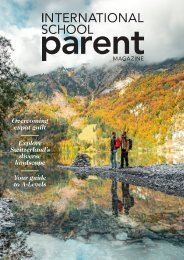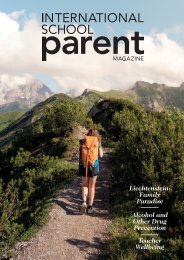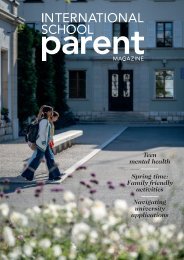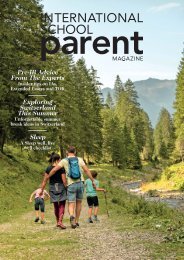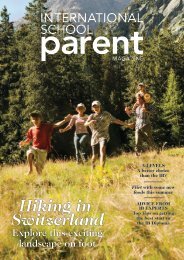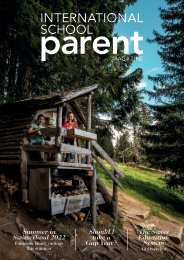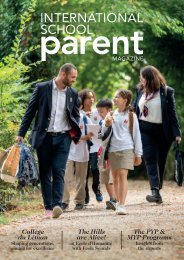International School Parent Magazine - Autumn 2019
- No tags were found...
You also want an ePaper? Increase the reach of your titles
YUMPU automatically turns print PDFs into web optimized ePapers that Google loves.
6It just doesn’t seem “natural.”
Actually, there is evidence in nature that gender diversity is
naturally occurring in plants, animals and humans. Gender
identity variation can be viewed as another natural expression of
science, genetics, biology and environment.
7Why is it happening so much more now?
There is evidence that for centuries, people in cultures
around the world (Native American, Thai, Nepalese, Indian,
Samoan, Hawaiian, various African tribes) demonstrated gender
diversity and/or “two-spirit” concepts in which people were
recognized to have a balance of male and female energies and to be
respected for their related knowledge and skills (Brown, Mar 2018).
It is true that gender diversity has gotten more media attention in
the past decade or so, but the concept of gender diversity is not new.
8What is the connection between gender identity and
sexual orientation?
The answer to this question is: There isn’t necessarily a
connection. It is important to understand that gender identity,
gender expression and sexual orientation are three very different
things that often get tangled when we speak about gender. As noted
earlier, although there are some gender expansive children who
later identify as gay, there are also many gender expansive children
who identify as heterosexual. Being transgender has nothing to
do with to whom you are romantically and sexually attracted. As
someone once explained to me (in an admittedly oversimplified way)
“Sexual orientation is whom you would like to go to bed WITH;
Gender identity is whom you would like to go to bed AS.” Those
are two totally separate things. The LGB and TQ communities
have worked together to help advocate for one another and may
fall under the same umbrella in organizations. But in reality your
internal felt sense of gender is totally separate from your patterns in
romantic attraction.
9I read somewhere that transgender kids have a lot of
mental health problems. Is this true?
It is true that many children and teens who are gender
expansive experience greater levels of anxiety and depression
than children who more easily land in our traditional gender
boxes. There is a social cost to pay for being different from others
and behaving in ways that are unexpected for teachers, parents
and other adults. Most of the available research is related to gay
children and teens and the statistics for them are startling. Dr.
Caitlin Ryan did research in 2010 that suggested: without parent
support (this is critical), lesbian and gay teens and young adults are
8 times more likely to attempt suicide. They are 6 times more likely
to experience anxiety and depression. They are 3 times more likely
to develop a substance abuse problem. Additionally, according to
research, they struggle to imagine that they can have happy healthy
lives as gay or lesbian young adults. However, research suggests
that with family support gay and lesbian teens are not at greater
risk for mental health problems than other teens (Ryan, C., 2010,
Le et.al, 2016, Travers, R., 2012, Wilson et.al., 2016). Clinical
experience suggests that gender expansive and transgender kids
are at greater risk for mental health problems (anxiety, depression,
attention concerns) especially if they do not have the support of
their parents and community. It’s the alienation, judgment and
questioning that takes it toll on a child’s wellness (Barrow, Apostle
2018). In a nutshell, there is no clear evidence that gender identity
concerns are always indicative of mental health concerns.
One of the many things we know about being part of the global
nomad community is that we find ourselves faced with learning
new things and understanding there are a myriad of ways to honor
others’ identities. We are often challenged to rethink what we used
to view as “normal” and we are skilled at respecting differences
within and among people.
Because of the above, global nomad parents have an advantage
making sense of the shifting public dialogue about gender identity,
and how these concepts relate to our kids. Part Two of this series
will specifically address how to support the gender expansive and
transgender children in your lives. There are fairly clear “do’s” and
“don’ts” with the kids in our communities, and we will discuss them
fully in Part Two.
Barrow, K., Apostle, D., (2018). Addressing Mental Health Conditions Often Experienced
by Transgender and Gender Expansive Children. The Gender Affirmative Model: An
Interdisciplinary Approach to Supporting Transgender and Gender Expansive Children, pp.
71-84.
Brown, E., Mar, K., (2018) Culturally Responsive Practice With Children of Color. The
Gender Affirmative Model: An Interdisciplinary Approach to Supporting Transgender and
Gender Expansive Children, pp. 55-70.
Ehrensaft, D. 2016. The Gender Creative Child: Pathways for Nurturing and Supporting
Children Who Live Outside Gender Boxes.
Keo-Meyer, C., Ehrensaft D., (Editors) The Gender Affirmative Model; An Interdisciplinary
Approach to Supporting Transgender and Gender Expansive Children. (2018).
Pepper, R., Brill, S. 2008. The Transgender Child. A Handbook for Families and
Professionals.
Ryan, C, Rusell, ST, Huebner, D Diaz, R, Sanchez, J. Family Acceptance in Adolescence
and the Health of LGBT Young Adults. Journal of Psychiatric Child and Adolescent Nursing.
2010; 23(4): 205-213
Dr. Laura Anderson has been a licensed child and
family psychologist for nearly twenty years. For
most of her career, Dr. Anderson ‘s offices have
been primarily based in school settings. She
has worked in public, private, international and
charter preschools, elementary, middle and high
schools. Dr. Anderson has expertise in learning and
behavioral assessments, emotional/behavioral interventions in
classrooms, working with adoptive families and working with genderexpansive
children and their families. Dr. Anderson is currently based in
Oakland California, and she provides national and international training
on a variety of child psychology topics. Dr. Anderson is a founding
member Parenting-in-the-Gap, a group under the umbrella of UCSF
Mind-the-Gap that focuses on training therapists to work effectively
with family members of gender expansive youth. In the past year, Dr.
Anderson has done presentations related to supporting LGBTQ youth
and their families at the Gender Spectrum Conference, the Hawaii
Psychological Association Annual Convention, the California Adoption
Connection conference and the Families In Global Transition conference
in Amsterdam. For both personal and professional reasons, Dr. Anderson
is passionate about supporting global nomad gender expansive, nonbinary,
and transgender youth and their families.
INTERNATIONAL SCHOOL PARENT AUTUMN 2019 | 51






